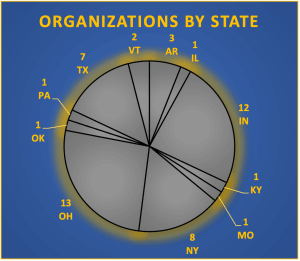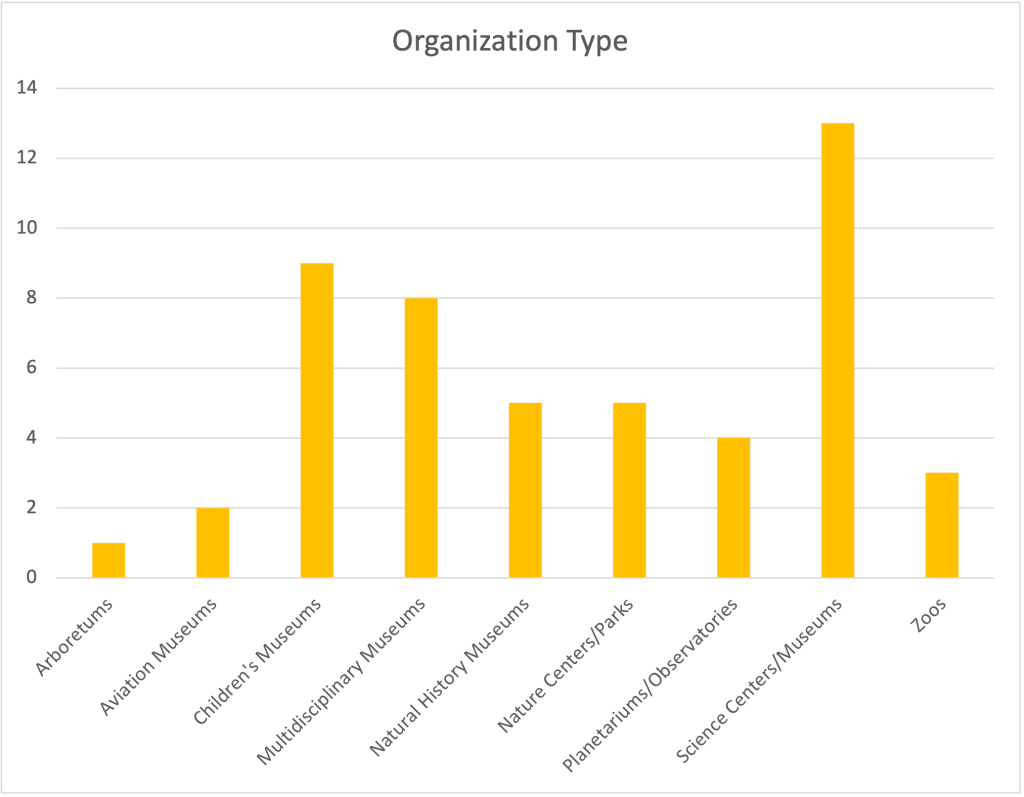
On April 8, 2024, a solar eclipse swept across North America.
Observers within its path of totality—a 115-mile-wide strip where the moon completely obscured the sun—experienced brief, total darkness in midafternoon. Many outside of the path experienced a partial eclipse, with a portion of the sun remaining visible.
The Association of Science & Technology Centers (ASTC)—thanks to funding from the Simons Foundation—marked this extraordinary event by hosting eclipse-related educational programming, viewing parties, and interactive events.
Fifty science-focused organizations in the path of totality were awarded $10,000 each to develop eclipse programming. The path of totality crossed thirteen U.S. states and organizations in eleven of those states were awarded funding: Texas, Oklahoma, Arkansas, Missouri, Illinois, Kentucky, Indiana, Ohio, Pennsylvania, New York, and Vermont.

What they all have in common is that science is central to their educational mission, operations, and programming. They included children’s museums, multidisciplinary museums (two or more significant disciplines), natural history museums, nature centers/parks, planetariums/observatories, science/technology centers, aviation museums, zoos, an arboretum and one historic Frank Lloyd Wright house!
They each did the following:
- Focused on programming specifically related to the 2024 solar eclipse.
- Engaged with their community around their eclipse programming.
Eclipse events and activities
Approximately 442,478 people were reached by these organizations in the path of totality, not including publicity and social media counts. Activities occurred in 38 towns or cities in 11 states. In addition, 325 community partnerships were reported by funded organizations including several grantees which collaborated with each other: three funded organizations reported collaborations with each other in Muncie, Indiana; two partnered in Dayton, Ohio; and two in Tupper Lake, New York. Four state parks across Ohio also collaborated and shared resources.
In terms of organization size (as defined by annual operating expense), 25 small organizations (under $1 million), 20 medium ($1-10 million), and 6 large (over $10 million) organizations received awards. Organizations also stretched across the rural-urban spectrum: 14 were rural, 18 were urban, and 18 were in between. Populations of the communities where these eclipse activities took place ranged from 3,000 (Minster, Ohio) to 1.38 million (Dallas, Texas).
Science-based outcomes
- Adirondack Sky Center & Observatory (Tupper Lake, New York) reports increased interest in becoming a Dark Sky Community, a local commitment to preserving dark skies from light pollution
- Toledo Zoo (Ohio) developed an ethogram to study eight species of animal during the eclipse with the public, collecting baseline data in the two weeks leading up to the eclipse and continuing data collection through partial and total eclipse
- Buffalo Museum of Science (New York) distributed 45,000 more pairs of glasses than expected, totaling nearly 345,000
- Westcott House (Springfield, Ohio) piloted a large-scale school field trip for 120 students to four sites focusing on sustainability and experiments related to solar power
Development of unique programs or resources
- Inland Waterways Museum (Paducah, Kentucky) developed a Braille eclipse pamphlet focusing on other senses than sight
- Charles W. Brown Planetarium (Muncie, Indiana) collaborated with NASA to live stream the eclipse using Ball State telescopes at the Indianapolis Motor Speedway
- Joseph Moore Museum (Richmond, Indiana) developed a pop-up exhibit utilizing adapted panels shared by fellow award recipient ECHO in Burlington, Vermont
- Staff from the Mayborn Museum at Baylor University (Waco, Texas) delivered over 100 in-person professional development eclipse trainings to schools and students reached exceeded 50,000
- Museum of Discovery (Little Rock, Arkansas) developed an eclipse-themed Social Story for neurodivergent audiences and distributed 500 printed copies; it was also shared online and highlighted in the Canadian Autism Newsletter
- SPI (Science Play-Space Initiative, Mount Vernon, Ohio) showcased a shadow puppet dramatization of “Tecumseh’s Eclipse” of 1806 which featured a representative of the Absentee Shawnee Tribe reading the chief’s own words in Shawnee, providing cultural context and teaching the audience key words
- The Wild Center (Tupper Lake, New York) provided live eclipse tattooing (yes, real tattoos!) which 30 people took part in
Other highlights
- ECHO (Burlington, Vermont) live streamed the eclipse on timeanddate.com, used by international media outlets to reach over 1-million households (watch here) and hosted the ABC National News’ special, Eclipse Across America, with David Muir and Linsey Davis, which was watched by over 4.8 million people (about twice the population of Mississippi)
- The National Museum of the United States Air Force (Dayton, Ohio) received so much publicity that they had to modify their initial plans for 10,000 guests to accommodate nearly 24,000
- Little Rock Zoo (Arkansas) welcomed special guests including Miss Arkansas Mackenzie Hinderberger, Mayor Frank Scott, Jr., and Governor Sarah Huckabee Sanders during the eclipse weekend
- Frontiers of Flight Museum (Dallas, Texas) received 294 mentions in the media related to the eclipse
- Cleveland Museum of Natural History (Ohio) counted 180 unique pieces of media coverage highlighting the Museum’s role in gathering the community




